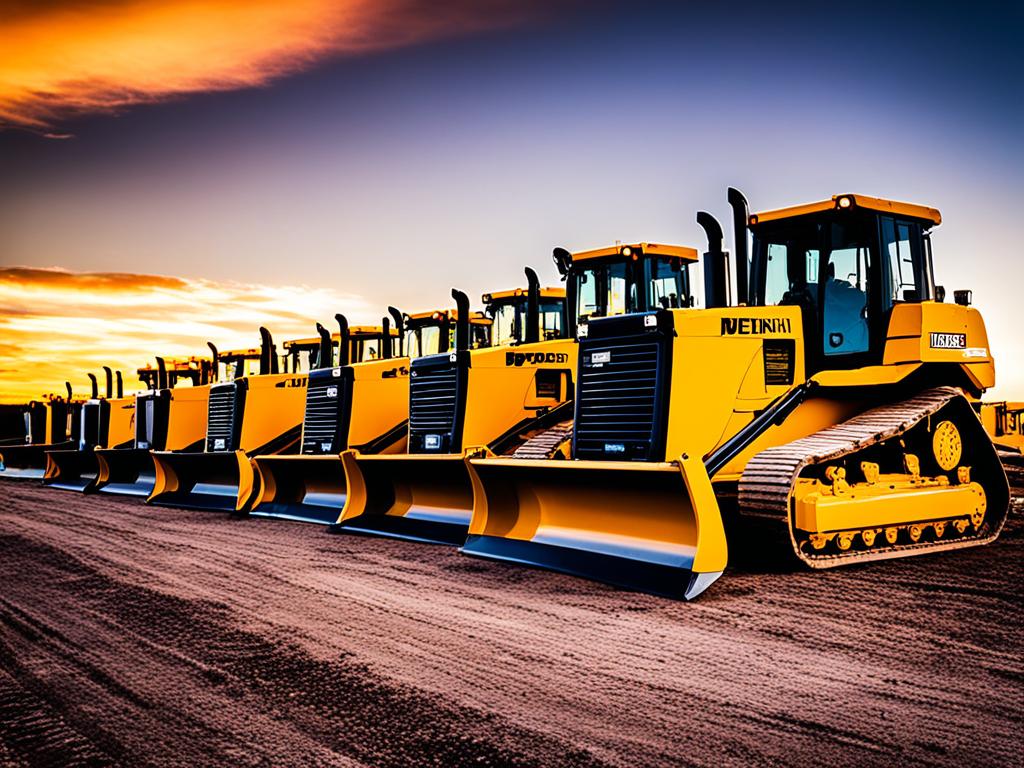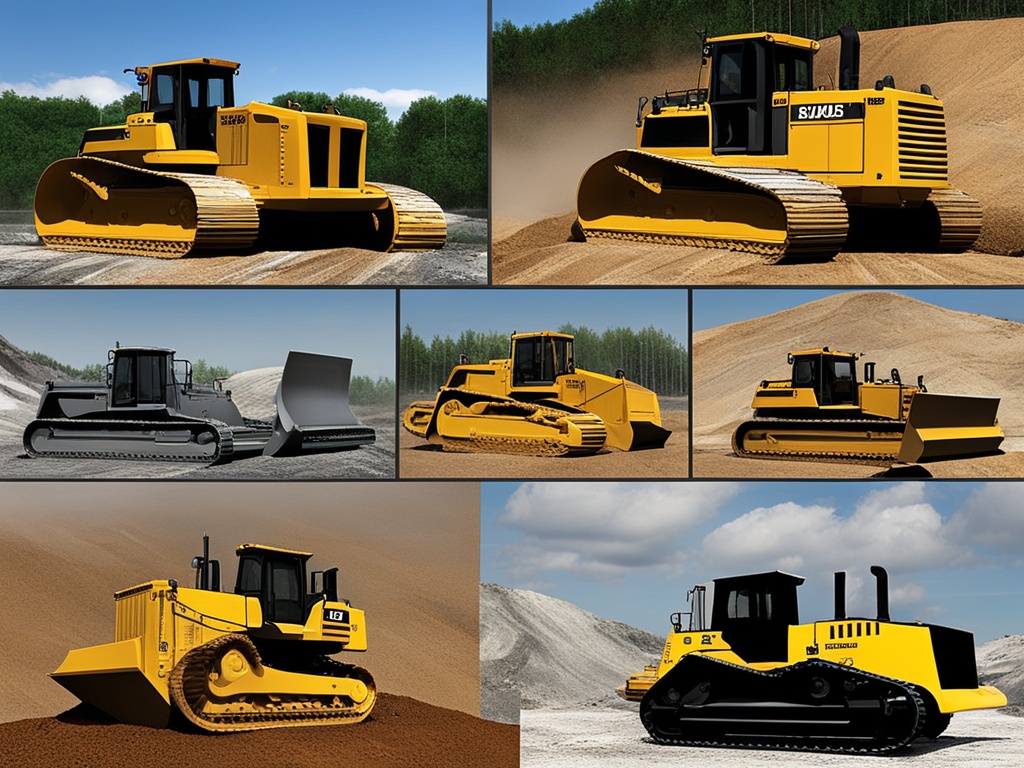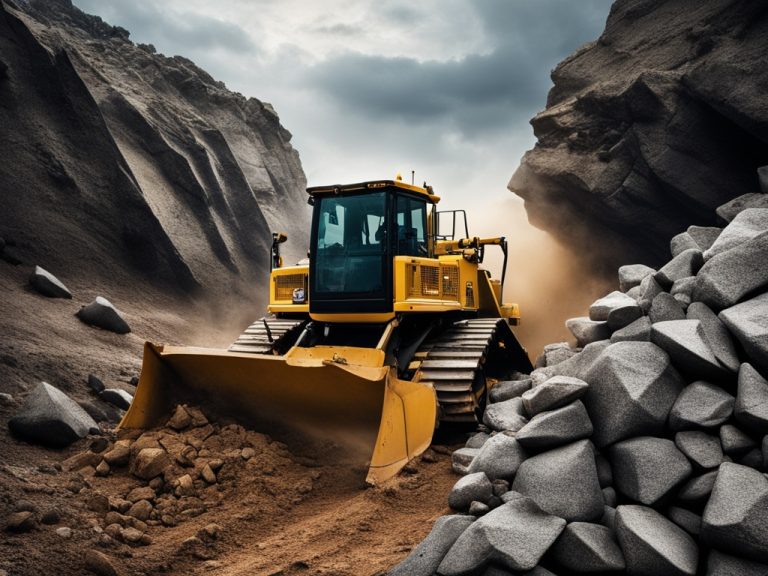Have you thought about why bull dozers are key in building things? These machines are vital for tough jobs in construction and more. They have strong engines, sturdy crawler tractors or wheels, and special blades. This lets them work in hard areas and move many types of materials.
But, do you know all they can do? What really makes them so needed in many areas, like earthmoving and site preparation?
Let’s learn about track-type tractors and earth haulers. We’ll explore dozers and why they are so important in our surroundings. Let’s find out how they boost work on construction sites.
Introduction to Dozers
Bulldozers, or dozers, are key in modern building and infrastructure work. These machines are strong and have special parts for tough jobs. They have powerful engines and can move on rough ground. Bulldozers can work with various materials like soil, gravel, or snow.
What is a Dozer?
A dozer is heavy equipment for moving earth and preparing sites. It can push, lift, and carry a lot of material. This makes it very important in building things, mining, and farming.
Significance of Dozers in Modern Construction and Infrastructure Development
Dozers are vital in many jobs, like getting sites ready, keeping roads good, and fixing up land. Their strength and ability to handle different tasks make a big difference. For example, they can make land even, dig for foundations, or clear the way for new buildings and roads.

Types of Dozers
The construction world has many dozer types, from crawler to wheel bulldozers. Each serves different needs. Crawler dozers with tracks handle rough terrain well. Wheel dozers, with tires, do better on smoother surfaces and are great for big projects.
Crawler Bulldozer
Crawler or track bulldozers move well through rough, soft, and steep areas. They are versatile, used for leveling roads, mining, and moving heavy stuff. These dozers are quite common for their adaptability.
Wheel Bulldozer
Wheel dozers are big and work best on easier surfaces like paved roads. They also do well on soft grounds such as sand. They are often seen in building highways, mining, and large construction projects.
Mini Bulldozer
Mini bulldozers are smaller, with less power, and are great for small areas. They’re perfect for jobs in residential places. Their size lets them work in tight spots, like for grading and back-filling.
Large Bulldozer
Large bulldozers are for tough jobs at big construction sites. They have a lot of power, big blades, and many advanced features. These machines boost work speed on complex projects.
Hybrid Bulldozer
Hybrid dozers use both electric and diesel to run. They’re good for the air and work quietly. Perfect for green projects in cities and commercial buildings. They save energy and reduce pollution.
| Dozer Type | Key Features | Preferred Applications |
|---|---|---|
| Crawler Bulldozer | Continuous tracks for excellent traction and stability in rough terrain | Leveling roads, mining operations, moving heavy objects |
| Wheel Bulldozer | Tires for use on paved surfaces and compacted soils; largest dozer type | Highway construction, mining, building large structures |
| Mini Bulldozer | Smaller size and reduced horsepower for confined spaces and light-to-medium tasks | Residential projects, grading, back-filling |
| Large Bulldozer | High horsepower, large blades, advanced features for increased productivity | Large-scale construction projects |
| Hybrid Bulldozer | Combines diesel and electric engines for improved efficiency and reduced emissions | Urban infrastructure, commercial building projects |

Dozer Blades: Types and Uses
Bulldozers come with many blade types for different jobs and terrains. Every blade has its own special features. This allows the user to pick the best one for the task. Tasks like clearing land, moving materials, or flattening surfaces.
Straight Blade
The straight blade is basic but very useful. It has a flat, straight edge that makes moving materials like soil and debris easy. It’s great for general earthmoving and handling materials.
U-Blade
The U-shaped blade can hold lots of material because of its curved design. This is perfect for moving soil, gravel, or snow. It’s a top pick for places like construction sites or when removing snow.
S-Blade
The S-shaped blade has an even bigger curve than the U-blade. This makes it better at moving and spreading materials, such as soil or gravel. It does great work at construction sites and other worksites.
Angle Blade
The angle blade can pivot left and right to move material in different ways. It’s very good for specific tasks like grading or shaping the land nicely. It is often used in making roads, getting a site ready, or landscaping.
Combination Blades
Combination blades can be set up in many different ways. They have both straight and angled edges. This lets users change how they cut or push materials. They’re great for many earthmoving jobs, from clearing land to handling materials.
Mastering the Terrain: The Power of Wheeled and Crawler Tractors
Bulldozers with wheeled tractors or crawler tractors are mighty. They can conquer tough land and boost work on construction sites. These machines have strong engines and advanced traction systems. They come with tools that help them handle tasks accurately, effectively, and powerfully in demanding environments.
They move well on rough terrains, soft soils, and steep slopes. Plus, they’re great at handling and moving big loads. This makes them very important in different industries.
| Feature | Average Specification |
|---|---|
| Track Length on the Ground | Approximately 10 feet for improved stability and maneuverability |
| Cab Height | 12 feet for medium-sized wheeled and crawler tractors, allowing for overhead obstacle clearance during transportation |
| Ground Clearance | Around 20 inches for wheeled and crawler tractors in forestry applications, aiding in maneuvering around obstacles and uneven terrain |
| Track Gauge | Approximately 80 inches, on average, to enhance performance on slopes |
| Operating Weight | Around 30,000 pounds for wheeled and crawler tractors with dozer blades and without rippers, ensuring machine stability during operation |
| Net Horsepower | Ranges between 200-300 horsepower, crucial for high productivity in heavy dozing operations |
These machines, filled with advanced features, make hard jobs a lot easier. Whether you’re at a construction site, clearing land, making roads, or going through tough land, they’re very useful. They boost your work’s productivity and help you reach your goals more efficiently, even in tough places.
Applications and Uses of Dozers
Bulldozers are used in many fields like construction, land clearing, and road work. They work in mining, forestry, and logging too. These tough machines handle heavy tasks well.
Construction Projects
Bulldozers are key for getting sites ready, moving earth, and leveling ground. They help clear away obstacles and set up strong bases for construction. This makes starting a building project much easier.
Land Clearing and Grading
For land preparation and grading, bulldozers are essential. They clear trees, rocks, and bushes, then level the ground. This is crucial for any plans on the land, from farming to building homes or businesses.
Road Building and Maintenance
In making and keeping roads, bulldozers are vital. They clear paths, move soil, and handle materials. This work is key for roads to be finished on time and run smoothly.
Mining and Quarrying
Bulldozers help take away topsoil, get minerals, and move materials in mines and quarries. Their strong build and power are perfect for these demanding jobs.
Forestry and Logging
In forestry, they aid in getting land ready, opening paths for cutting trees, and moving logs. Their adaptability and force are important for handling woodlands well.
Bulldozers are clearly very important in different sectors needing earth-moving and shaping abilities. They are critical in construction, mining, and forestry, helping to change our world.
Conclusion
Choosing the best dozer is very important for getting good work done without spending too much. You need to think about things like how big it is, how much power it has, the brand, the model, and its condition and age. Also, any optional features it might have are key. These factors help you pick the right dozer for your building, mining, or farming jobs.
Bulldozers are key in many fields today, such as construction, agriculture, mining, and forestry. Knowing about different types of dozers, what they’re made of, and how they’re used helps you make smart choices for your big tasks. This means you can work better and more accurately.
The dozer world is always changing. Now, we see hybrid and electric dozers, as well as ones with smart GPS and telematics. It’s important to keep up with these new trends and technologies. Doing so keeps your work at the top in terms of tech and productivity.
